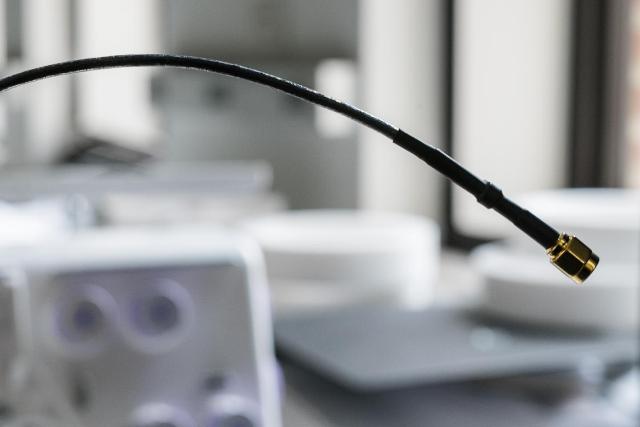Jan 28 2016
Scientists from Rice University have developed a new nanotube-based outer conductor that helps reduce 50% weight of common coaxial cables.
 A coating of carbon nanotubes, seen through a clear jacket, replaces a braided metal outer conductor in an otherwise standard coaxial data cable. Rice University scientists designed the cable to save weight for aerospace applications. CREDIT: Jeff Fitlow/Rice University)
A coating of carbon nanotubes, seen through a clear jacket, replaces a braided metal outer conductor in an otherwise standard coaxial data cable. Rice University scientists designed the cable to save weight for aerospace applications. CREDIT: Jeff Fitlow/Rice University)
The Rice lab, headed by Professor Matteo Pasquali, have created a coating that can be used as an alternative to copper braids with a tin coating. The tin-coated copper braids send a signal and also protect the cable from electromagnetic disturbance, and the braids are the heaviest component in modern coaxial data cables.
ACS Applied Materials and Interfaces, the American Chemical Society journal, recently published a report on this research by Rice University scientists.
The new coating has high-performance and flexibility. These two features are beneficial for both spacecraft and airplanes, where the strength and weight of cables carrying data play a vital role in their performance.
Francesca Mirri, a research scientist at Rice University and chief author of the paper, altered the thickness of the carbon-nanotube to create three different versions of the new cable. The thickest, about 90 µm and almost the width of an individual’s hair, fulfilled the military-grade shielding standards and was the robust. 10,000 bending cycles were handled without hindering the performance of the cable.
Current coaxial cables have to use a thick metal braid to meet the mechanical requirements and appropriate conductance. Our cable meets military standards, but we’re able to supply the strength and flexibility without the bulk.
Francesca Mirri, Research Scientist, Rice University
The four elements that make up coaxial cables include a polymer jacket, an outer conductor, an electrically insulating polymer sheath, and a conductive copper core. The scientists replaced only the outer conductor, using a mixture of carbon nanotubes in chlorosulfonic acid to coat the sheathed cores. Pasquali stated that, this technique, when compared with the previous efforts of using carbon nanotubes in cables, helps to develop a conductor that is more uniformed and has a higher throughput.
This is one of the few cases where you can have your cake and eat it, too. We obtained better processing and improved performance.
Matteo Pasquali, Professor, Rice University
Mirri stated that 97% of the component’s mass was eliminated using the nanotube coating instead of the braided metal conductor. She also explained that the Rice lab is currently working on a technique to increase the level of production, using its experience in the production of high-performance nanotube-based fibers.
It’s a very similar process. We just need to substitute the exit of the fiber extrusion setup with a wire-coating die. These are high-throughput processes currently used in the polymer industry to make a lot of commercial products. The Air Force seems very interested in this technology, and we are currently working on a Small Business Innovation Research project with the Air Force Research Laboratory to see how far we can take it.
Francesca Mirri, Research Scientist, Rice University
Co-authors are graduate students Robert Headrick and Amram Bengio and alumni April Choi and Yimin Luo, all of Rice; Nathan Orloff, Aaron Forster, Angela Hight Walker, Paul Butler and Kalman Migler of the National Institute of Standards and Technology (NIST); Rana Ashkar of NIST, the University of Maryland and Oak Ridge National Laboratory; and Christian Long of NIST and the University of Maryland.
Pasquali is the A.J. Hartsook Professor of Chemical and Biomolecular Engineering, chair of the Department of Chemistry and a professor of materials science and nanoengineering and of chemistry.
The study was supported by the Robert A. Welch Foundation, by the Air Force Office of Scientific Research, the National Science Foundation, NIST, a NASA Space Technology Research Fellowship, and the Air Force Research Laboratories.